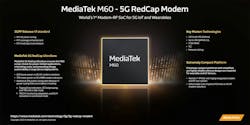Bringing the Power of RedCap 5G to the IoT
What you’ll learn:
- Insight into RedCap 5G NR and its capabilities.
- An overview of MediaTek’s T300 5G RedCap platform.
- Potential applications.
With the introduction of affordable and power-efficient single-board computers (SBCs) and microcontrollers over the last two decades, the number of connected devices has skyrocketed. It’s estimated that the number of those connected devices will reach 29 billion by 2030. That’s a ton of IoT devices, all of which will be vying for a 5G connection.
To that end, companies and manufacturers are taking advantage of 3GPP’s RedCap 5G NR technology (reduced capability 5G NR). It represents a significant leap forward over other technologies, such as low-power wide-area networking (LPWAN).
RedCap harnesses the power of 5G NR to provide increased performance, reduced latencies, and enhanced power efficiencies when compared to earlier solutions like LTE-M and NB-IoT. Thus, RedCap 5G NR devices can take advantage of the technology for faster data transmission, real-time responsiveness, and a longer battery life.
New IoT Platform Leverages RedCap Release 17
Companies have already begun to release technologies that can take advantage of RedCap 5G NR with Release 17, which provides enhancements that allow for next-generation IoT devices to run on 5G networks. MediaTek, a leading innovator of chip design, MediaTek is one of those companies that leveraged RedCap 5G NR with its T300 platform for IoT applications. The chip was designed around the Release 17 standard, which ensures compatibility with future network upgrades and features when they become available.
The T300 packs an Arm Cortex-A35 SoC and features a simplified and reliable antenna with integrated RF to prolong battery life while minimizing development time and costs. It also integrates MediaTek’s M60 5G modem (Fig. 1) that’s tailored specifically for RedCap applications. In turn, the chip’s power efficiency and performance are enhanced by 60% compared to LTE Cat-4 devices, and up to 70% compared to 5G eMMB solutions.
Furthermore, there’s an additional 10% reduction of power consumption with Release 17. Power-saving features include Paging Early Indication, UE Subgrouping, TRS info in idle mode, PDCCH monitoring adaptation, and RLM relaxation in connected mode. The M60 also packs a number of modem technologies, including R17 UE power saving, R17 coverage enhancement, R17 small data transmission, LTE and NR-FR1 (@ 20 MHz) up to 256 QAM DL/UL, T2R MIMO/1CC and network slicing.
T300 Fits into a Wide Array of Applications
MediaTek’s T300 can be used for myriad applications that range from wearable devices to the IIoT. Factories and warehouses can take advantage of real-time data collection and machine monitoring with minimal power use, which helps minimize downtime and system maintenance. Remote patient monitoring is another application that can benefit from the T300, enabling medical professionals to garner information in real-time for improved healthcare. The same can be said for fitness trackers and smart glasses.
The T300 can also be used in smart-city infrastructure to efficiently monitor traffic, environmental conditions, and waste management. It’s well-suited for cellular IoT applications, too, including surveillance cameras and body cameras used by law enforcement.
According to MediaTek, it’s collaborating with leading infrastructure and operator partners worldwide to successfully connect to 5G SA networks and conduct Voice over New Radio (VoNR) calls and data transmissions using the T300. Of course, the T300 depends on RedCap to access all of its features.
Rollouts show wide-scale adoption in the U.S. beginning this year (2024) for data-only applications (Fig. 2), with wearable access coming by 2025. The EU and Australia are currently in the planning stages for the RedCap rollout, while China is on track with the same U.S. schedule. Japan is slated to begin planning by 2025.
Specialized Configurations
MediaTek will also introduce a configuration mode to better suit specific applications. The Wearable Configuration prioritizes cellular-connected wearable technologies. It will support booting from a host device, providing an extremely low latency when using warm start, stacked DRAM, and advanced packaging to minimize the PCB footprint.
In the IoT Configuration, the T300 is expected to feature flexible memory choices, provide multiple interfaces and feature low active and standby power while still retaining video-streaming capabilities. Both configurations should be introduced by 2027, after the RedCap rollout.
The MediaTek T300 RedCap 5G platform is a game-changer in the world of connected IoT devices, taking a giant leap forward in enabling a connected future. Its increased power efficiency, robust performance, and compliance with 5G standards will pave the way for next-gen innovative applications across a wide range of industries.
As countries edge closer to a more interconnected world, the T300 stands ready to play a pivotal role in that connectivity, delivering higher levels of efficiency and reliability for the next generation of IoT and wearable devices.
Read more articles in the TechXchange: Wireless IoT Technologies.
About the Author
Cabe Atwell
Technology Editor, Electronic Design
Cabe is a Technology Editor for Electronic Design.
Engineer, Machinist, Maker, Writer. A graduate Electrical Engineer actively plying his expertise in the industry and at his company, Gunhead. When not designing/building, he creates a steady torrent of projects and content in the media world. Many of his projects and articles are online at element14 & SolidSmack, industry-focused work at EETimes & EDN, and offbeat articles at Make Magazine. Currently, you can find him hosting webinars and contributing to Electronic Design and Machine Design.
Cabe is an electrical engineer, design consultant and author with 25 years’ experience. His most recent book is “Essential 555 IC: Design, Configure, and Create Clever Circuits”
Cabe writes the Engineering on Friday blog on Electronic Design.




